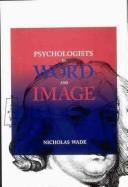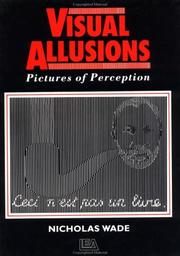| Listing 1 - 10 of 37 | << page >> |
Sort by
|
Book
ISBN: 9781594202285 Year: 2009 Publisher: New York, N.Y. The Penguin Press
Abstract | Keywords | Export | Availability | Bookmark
 Loading...
Loading...Choose an application
- Reference Manager
- EndNote
- RefWorks (Direct export to RefWorks)
Draws on a broad range of scientific evidence to theorize an evolutionary basis for religion, considering how religion may have served as an essential component of early society survival and that the brain may be inherently inclined toward religious behavior.
Sociology of religion --- Religion --- Philosophy.

ISBN: 0262731126 0262231808 Year: 1995 Publisher: Cambridge, Mass. : MIT Press,
Abstract | Keywords | Export | Availability | Bookmark
 Loading...
Loading...Choose an application
- Reference Manager
- EndNote
- RefWorks (Direct export to RefWorks)
We are all fascinated by physiognomy, intrigued by the appearance of the people we admire. These perceptual portraits of more than 100 thinkers who have fashioned our understanding of mind and behavior provide an alternative view of the history of psychology that is both pleasing and puzzling.Francis Bacon, René Descartes, Pierre Broca, Sigmund Freud, Carl Jung, Ruth Benedict, Allen Newell, David Marr and scores of others whose ideas have made psychology an empirical discipline emerge from motifs specifically drawn by the author or derived from a figure or text in one of the portrayed person's books, or an apparatus he or she invented. The ingenious treatment of portrait/motifs often challenges the viewer to discern the faces embedded in them and always tells us more than how these students of mind looked: these portraits reflect their thoughts and lead us to forage further into their lives and legacies.The portraits and motifs have been manipulated in a variety of ways, using graphic and photographic procedures. They are arranged in order of birth date in a format of one page of descriptive text facing a full-page perceptual portrait. The text presents a brief synopsis of the person portrayed, that person's ideas, and the source of both the portrait and the motif. Interrelations between people are stressed, bringing to light common threads that run through the work of particular groups and adding yet another level to this unique gallery of psychology's pioneers.
Psychology --- History
Book
ISBN: 0710008686 Year: 1982 Publisher: London : Routledge and Kegan Paul,
Abstract | Keywords | Export | Availability | Bookmark
 Loading...
Loading...Choose an application
- Reference Manager
- EndNote
- RefWorks (Direct export to RefWorks)
159.931 --- 612.843.7 --- Optical illusions --- #SBIB:309H526 --- Illusions, Optical --- Hallucinations and illusions --- Physiological optics --- Visual perception --- Zien. --- Visual perception. Spatial vision. Binocular vision. Stereoscopy --- Psychologie van de audiovisuele boodschap --- Optical illusions. --- 612.843.7 Visual perception. Spatial vision. Binocular vision. Stereoscopy --- 159.931 Zien. --- Zien
Book
ISBN: 3319252275 3319252291 Year: 2016 Publisher: Cham : Springer International Publishing : Imprint: Springer,
Abstract | Keywords | Export | Availability | Bookmark
 Loading...
Loading...Choose an application
- Reference Manager
- EndNote
- RefWorks (Direct export to RefWorks)
We delight in using our eyes, particularly when puzzling over pictures. Art and illusionists is a celebration of pictures and the multiple modes of manipulating them to produce illusory worlds on flat surfaces. This has proved fascinating to humankind since the dawning of depiction. Art and illusionists is also a celebration of the ways we see pictures, and of our ability to distil meaning from arrays of contours and colours. Pictures are not only a source of fascination for artists, who produce them, but also for scientists, who analyse the perceptual effects they induce. Illusions provide the glue to cement the art and science of vision. Painters plumb the art of observation itself whereas scientists peer into the processes of perception. Both visual artists and scientists have produced patterns that perplex our perceptions and present us with puzzles that we are pleased to peruse. Art and illusionists presents these two poles of pictorial representation as well as presenting novel ‘perceptual portraits’ of the artists and scientists who have augmented the art of illusion. The reader can experience the paradoxes of pictures as well as producing their own by using the stereoscopic glasses enclosed and the transparent overlay for making dynamic moiré patterns.
Telecommunications --- Electrical Engineering --- Applied Physics --- Electrical & Computer Engineering --- Engineering & Applied Sciences --- Art --- Optical illusions. --- Psychological aspects. --- Illusions, Optical --- Art, Occidental --- Art, Visual --- Art, Western (Western countries) --- Arts, Fine --- Arts, Visual --- Fine arts --- Iconography --- Occidental art --- Visual arts --- Western art (Western countries) --- Engineering. --- Arts. --- Graphic design. --- Popular works. --- Computational intelligence. --- Cognitive psychology. --- Signal, Image and Speech Processing. --- Popular Science, general. --- Cognitive Psychology. --- Graphic Design. --- Computational Intelligence. --- Psychology, Cognitive --- Cognitive science --- Psychology --- Intelligence, Computational --- Artificial intelligence --- Soft computing --- Arts, Occidental --- Arts, Western --- Humanities --- Construction --- Industrial arts --- Technology --- Hallucinations and illusions --- Physiological optics --- Visual perception --- Arts --- Aesthetics --- Science (General). --- Consciousness. --- Architectural design. --- Design --- Structural design --- Apperception --- Mind and body --- Perception --- Philosophy --- Spirit --- Self --- Signal processing. --- Image processing. --- Speech processing systems. --- Computational linguistics --- Electronic systems --- Information theory --- Modulation theory --- Oral communication --- Speech --- Telecommunication --- Singing voice synthesizers --- Pictorial data processing --- Picture processing --- Processing, Image --- Imaging systems --- Optical data processing --- Processing, Signal --- Information measurement --- Signal theory (Telecommunication) --- Arts, Primitive
Book
ISBN: 0393023354 Year: 1987 Publisher: London : Sidgwick & Jackson,
Abstract | Keywords | Export | Availability | Bookmark
 Loading...
Loading...Choose an application
- Reference Manager
- EndNote
- RefWorks (Direct export to RefWorks)
Book
ISBN: 9781594204463 Year: 2014 Publisher: New York : The Penguin Press,
Abstract | Keywords | Export | Availability | Bookmark
 Loading...
Loading...Choose an application
- Reference Manager
- EndNote
- RefWorks (Direct export to RefWorks)
Human evolution. --- Sociobiology. --- Race. --- Civilization, Western.

ISBN: 0863771300 Year: 1992 Publisher: Hove Lawrence Erlbaum Associates
Abstract | Keywords | Export | Availability | Bookmark
 Loading...
Loading...Choose an application
- Reference Manager
- EndNote
- RefWorks (Direct export to RefWorks)
Physiology of nerves and sense organs --- visual perception --- Sociology --- perception --- optical illusion --- Psychology --- #SBIB:309H526 --- Psychologie van de audiovisuele boodschap

ISBN: 1594200793 9781594200793 Year: 2006 Publisher: New York (N.Y.) Penguin press
Abstract | Keywords | Export | Availability | Bookmark
 Loading...
Loading...Choose an application
- Reference Manager
- EndNote
- RefWorks (Direct export to RefWorks)
BPB0701 --- 572.1/.4 --- 213 --- 575.8 --- 575.8 Evolution. Origin of species. Phylogeny --- Evolution. Origin of species. Phylogeny --- 572.1/.4 Anthropogeny. Human development in general. Origin of the human species --- Anthropogeny. Human development in general. Origin of the human species --- Schepping. Emanatisme. Evolutionisme. Creationisme. Eeuwigheid van de wereld --- Human evolution. --- Social evolution. --- Human evolution --- Social evolution --- Cultural evolution --- Cultural transformation --- Culture, Evolution of --- Culture --- Evolution --- Social change --- Evolution (Biology) --- Physical anthropology --- Evolutionary psychology --- Human beings --- Origin
Book
ISBN: 3030779955 3030779947 Year: 2023 Publisher: Cham : Springer International Publishing : Imprint: Springer,
Abstract | Keywords | Export | Availability | Bookmark
 Loading...
Loading...Choose an application
- Reference Manager
- EndNote
- RefWorks (Direct export to RefWorks)
This book celebrates binocular vision by presenting illustrations that require two eyes to see the effects of cooperation and competition between them. Pictures are flat but by printing them in different colours and viewing them through similarly coloured filters (included with the book) they are brought to life either in stereoscopic depth or in rivalry with one another. They are called anaglyphs and all those in the book display the ways in which the eyes interact. Thus, the reader is an integral element in the book and not all readers will see the same things. The history, science and art of binocular vision can be experienced in ways that are not usually available to us and with images made specifically for this book. The study of vision with two eyes was transformed by the invention of stereoscopes in the early 19th century. Anaglyphs are simple forms of stereoscopes that have three possible outcomes from viewing them – with each eye alone to see the monocular images, with both eyes to see them in stereoscopic depth or rivalry, or without the red/cyan glasses where they can have an appeal independent of the binocularity they encompass. Through the binocular pictures and the words that accompany them there will be an appreciation of just how remarkable the processes are that yield binocular singleness and depth. Moreover, the opportunities for expressing these processes are explored with many examples of truly binocular art.
Signal processing. --- Mathematics. --- Science. --- Life sciences. --- Social sciences. --- Humanities. --- Engineering. --- Digital and Analog Signal Processing. --- Mathematics and Computing. --- Physical Sciences. --- Life Sciences. --- Humanities and Social Sciences. --- Technology and Engineering. --- Construction --- Industrial arts --- Technology --- Learning and scholarship --- Classical education --- Behavioral sciences --- Human sciences --- Sciences, Social --- Social science --- Social studies --- Civilization --- Biosciences --- Sciences, Life --- Science --- Natural science --- Natural sciences --- Science of science --- Sciences --- Math --- Processing, Signal --- Information measurement --- Signal theory (Telecommunication) --- Art --- Processament de senyals --- Ciències de la vida --- Ciències socials
Multi
ISBN: 9783319252292 9783319252278 Year: 2016 Publisher: Cham Springer International Publishing
Abstract | Keywords | Export | Availability | Bookmark
 Loading...
Loading...Choose an application
- Reference Manager
- EndNote
- RefWorks (Direct export to RefWorks)
We delight in using our eyes, particularly when puzzling over pictures. Art and illusionists is a celebration of pictures and the multiple modes of manipulating them to produce illusory worlds on flat surfaces. This has proved fascinating to humankind since the dawning of depiction. Art and illusionists is also a celebration of the ways we see pictures, and of our ability to distil meaning from arrays of contours and colours. Pictures are not only a source of fascination for artists, who produce them, but also for scientists, who analyse the perceptual effects they induce. Illusions provide the glue to cement the art and science of vision. Painters plumb the art of observation itself whereas scientists peer into the processes of perception. Both visual artists and scientists have produced patterns that perplex our perceptions and present us with puzzles that we are pleased to peruse. Art and illusionists presents these two poles of pictorial representation as well as presenting novel ?perceptual portraits? of the artists and scientists who have augmented the art of illusion. The reader can experience the paradoxes of pictures as well as producing their own by using the stereoscopic glasses enclosed and the transparent overlay for making dynamic moiré patterns.
Science --- Cognitive psychology --- Applied physical engineering --- Artificial intelligence. Robotics. Simulation. Graphics --- Computer. Automation --- Art --- Graphic arts --- Linguistics --- neuronale netwerken --- beeldverwerking --- fuzzy logic --- cybernetica --- popularisering wetenschap --- populaire cultuur --- grafische vormgeving --- kunst --- cognitieve psychologie --- KI (kunstmatige intelligentie) --- ingenieurswetenschappen --- signaalverwerking --- Hallucinations and illusions in art --- Optical illusions in art --- Cognitive psychology. --- Illusions dans l'art --- Illusions d'optique dans l'art --- Psychologie cognitive --- AI (artificiële intelligentie)
| Listing 1 - 10 of 37 | << page >> |
Sort by
|

 Search
Search Feedback
Feedback About UniCat
About UniCat  Help
Help News
News